Direct Detection of Severe Biomass Burning Aerosols from Satellite Data
Abstract
:1. Introduction
2. Method
2.1. Detection of SBBAs with SGLI Near-UV Data
- For AOT ≤ 0.3, the effect of ground surface reflection can be seen (as the aerosols are optically thin and the ground can clearly be seen). In particular, for BBAs, the histograms show two peaks, indicating a difference in the AAI between reflected and scattered light. There is no apparent bimodal shape for dust, probably because dust aerosols are derived initially from desert soils and have the same wavelength characteristics.
- Most of the aerosols exist in AOT ≤ 2. As a result, AAI values are concentrated in this region, and the mean value for the entire AOT region is within 0.3 < AOT ≤ 2. This tendency is particularly strong in the case of dust, with almost all data falling within AOT ≤ 2. Therefore, the units on the vertical axis in Figure 2(d3) were changed. Naturally, it is necessary to take into account that the number of dust data items is only two-thirds that of the BBAs, that the data is limited to the Sahara Desert, and that it is challenging to retrieve the AOT from the satellite over the desert.
- The AAI values increase with AOT for BBAs and may exceed 1.1, around the limit value of AOT, which is 5. Then, BBAs with AOT (500) > 5, which are not derived in the official product, are referred to as SBBAs in this work.
- In the case of dust, the increasing trend in the AAI values with AOT stops around AOT = 2, converges, and never exceeds 1.1. Therefore, AAI = 1.1 can be regarded as a threshold that differentiates between SBBAs and dense dust. This is the intention of the arrows at both ends drawn in Figure 2a,c.
2.2. Detection of SBBAs with Polarized Radiance
3. Specific Results of SBBA Detection
4. Discussion: Role of Polarization
- The value of the PR (674) increases with AOT up to AOT (500) ≈ 2 (i.e., AOT (674) ≈ 1) while maintaining a higher value than PR (869) and then converging to a constant value;
- The value of the PR (869) increases with AOT up to AOT (500) ≈ 4 (i.e., AOT (869) ≈ 1) and continues to increase slowly thereafter. The PR (869) has higher values than PR (674) after AOT (500) ≈ 2;
- The resulting PRI, the ratio of the PR (869) to PR (674), exceeds 1 after AOT (500) ≈ 2 and has a value of 1.2 at AOT (500) = 10, the maximum value of AOT (500) in Figure 8;
- The R values at both wavelengths increase with AOT.
5. Summary and Future Plans
Author Contributions
Funding
Institutional Review Board Statement
Informed Consent Statement
Acknowledgments
Conflicts of Interest
References
- Stohl, A.; Berg, T.; Burkhart, J.F.; Fjaraa, A.M.; Forster, C.; Herber, A.; Hov, O.; Lunder, C.; McMillan, W.W.; Oltmans, S.; et al. Arctic smoke record air pollution levels in the European Arctic during a period of abnormal warmth, due to agricultural fires in Eastern Europe. Atmos. Chem. Phys. 2007, 7, 511–534. [Google Scholar] [CrossRef] [Green Version]
- Markar, P.; Akingunola, A.; Chen, J.; Pabla, B.; Gong, W.; Stroud, C.; Sioris, C.; Anderson, K.; Cheung, P.; Zhang, J.; et al. Forest fire aerosol- weather feedback over western North America using a high-resolution, fully coupled, air quality model. Atmos. Chem. Phys. 2020, 21, 10557–10587. [Google Scholar] [CrossRef]
- IPCC. Climate Change 2021: The Physical Science Basis; Contribution of working group I to the sixth assessment report of the Intergovernmental Panel on Climate Change; Cambridge University Press: Cambridge, UK, 2021. [Google Scholar]
- Konovalov, I.; Golovushkin, N.; Beekmann, M.; Turquety, S. Using multi-platform satellite observations to study the atmospheric evolution of brown carbon in Siberian biomass burning plumes. Remote Sens. 2022, 14, 2625. [Google Scholar] [CrossRef]
- Tan-Sooa, J.-S.; Pattanayak, S.K. Seeking natural capital projects: Forest fires, haze, and early-life exposure in Indonesia. Proc. Natl. Acad. Sci. USA 2019, 116, 5239–5245. [Google Scholar] [CrossRef] [PubMed] [Green Version]
- Sastry, N. Forest fires, air pollution, and mortality in Southeast Asia. Demography 2002, 39, 1–23. [Google Scholar] [CrossRef] [PubMed]
- Sahu, R.K.; Hari, M.; Tyagi, B. Forest fire induced air pollution over Eastern India during March 2021. Aerosol Air Qual. Res. 2022, 22, 220084. [Google Scholar] [CrossRef]
- Poulos, G.; Pielke, R. A numerical analysis of Los Angeles basin pollution transport to the Grand Canyon under stably stratified Southwest flow conditions. Atmos. Environ. 1994, 28, 3329–3357. [Google Scholar] [CrossRef]
- Sayer, A.; Hsu, N.; Eck, T.; Smirnov, A.; Holben, B. AERONET-based models of smoke-dominated aerosol near source regions and transported over ocean, and implications for satellite retrievals of aerosol optical depth. Atmos. Chem. Phys. 2014, 14, 11493–11523. [Google Scholar] [CrossRef] [Green Version]
- Dickman, K. The hidden toll of wildfire. Sci. Am. 2020, 322, 38–45. [Google Scholar]
- Liu, J.C.; Pereira, G.; Uhl, S.A.; Bravo, M.A.; Bell, M.L. A systematic review of the physical health impacts from non-occupational exposure to wildfire smoke. Environ. Res. 2015, 136, 120–132. [Google Scholar] [CrossRef] [PubMed] [Green Version]
- Cascio, W.E. Wildland fire smoke and human health. Sci. Total Environ. 2018, 624, 586–595. [Google Scholar] [CrossRef]
- Rappold, A.G.; Stone, S.L.; Cascio, W.E.; Neas, L.M.; Kilaru, V.J.; Carraway, M.S.; Vaughan-Batten, H. Peat bog wildfire smoke exposure in rural North Carolina is associated with cardiopulmonary emergency department visits assessed through syndromic surveillance. Environ. Health Perspect. 2011, 119, 1415. [Google Scholar] [CrossRef] [PubMed] [Green Version]
- Reid, C.E.; Brauer, M.; Johnston, F.H.; Jerrett, M.; Balmes, J.R.; Elliott, C.T. Critical review of health impacts of wildfire smoke exposure. Environ. Health Perspect. 2016, 124, 1334–1343. [Google Scholar] [CrossRef] [Green Version]
- Li, F.; Vogelmann, A.; Ramanathan, V. Saharan dust aerosol radiative forcing measured from space. J. Clim. 2004, 17, 2558–2571. [Google Scholar] [CrossRef]
- Lee, K.; Kim, Y. Satellite remote sensing of Asian aerosols: A case study of clean, polluted and dust storm days. Atmos. Meas. Tech. 2010, 3, 1771–1784. [Google Scholar] [CrossRef] [Green Version]
- Diemoz, H.; Barnaba, F.; Magri, T.; Pession, G.; Dionisi, D.; Pittavino, S.; Tombolato, I.K.F.; Campanelli, M. Sofia, L.D.C.; Hervo, M.; et al. Transport of Po Valley aerosol pollution to the northwestern Alps—Part 1: Phenomenology. Atmos. Chem. Phys. 2019, 19, 3065–3095. [Google Scholar] [CrossRef] [Green Version]
- Hu, W.; Zhao, T.; Bai, Y.; Shen, L.; Sun, X.; Gu, Y. Contribution of regional PM2.5 transport to air pollution enhanced by sub-basin topography, A modeling case over Central China. Atmosphere 2020, 11, 1258. [Google Scholar] [CrossRef]
- Torres, O.; Bhartia, P.K.; Herman, J.R.; Ahmad, Z. Derivation of aerosol properties from satellite measurements of backscattered ultraviolet radiation: Theoretical basis. J. Geophys. Res. 1998, 103, 17099–17110. [Google Scholar] [CrossRef]
- King, M.; Menzel, P.; Kaufman, Y.; Tanré, D.; Gao, B.; Platnick, S.; Ackerman, S.; Remer, L.; Oincus, R.; Hubanks, P. Cloud and aerosol properties, precipitable water, and profiles of temperature and water vapor from MODIS. IEEE Trans. Geosci. Remote Sens. 2003, 41, 442–458. [Google Scholar] [CrossRef] [Green Version]
- Deuze’, J.; Bre’on, F.; Devaux, C.; Goloub, P.; Herman, M.; Lafrance, B.; Maignan, F.; Marchand, A.; Nadal, F.; Perry, G.; et al. Remote sensing of aerosols over land surfaces from POLDER/ADEOS-1 polarized measurements. J. Geophys. Res. 2001, 106, 4913–4926. [Google Scholar] [CrossRef] [Green Version]
- Waquet, F.; Cornet, C.; Deuz’e, J.; Dubovik, O.; Ducos, F.; Goloub, P.; Herman, M.; Lapyonok, T.; Labonnote, L.; Riedi, J.; et al. Retrieval of aerosol microphysical and optical properties above liquid clouds from POLDER/PARASOL polarization measurements. Atmos. Meas. Tech. 2013, 6, 991–1016. [Google Scholar] [CrossRef]
- Liao, H.; Seinfeld, J. Effect of clouds on direct aerosol radiative forcing of climate. J. Geophys. Res. 1998, 103, 3781–3788. [Google Scholar] [CrossRef]
- Quaas, J.; Boucher, O.; Bellouin, N.; Kinne, S. Satellite-based estimate of the direct and indirect aerosol climate forcing. J. Geophys. Res. 2008, 113, D05204. [Google Scholar] [CrossRef]
- Ten Hoeve, J.E.; Remer, L.A.; Jacobson, M.Z. Microphysical and radiative effects of aerosols on warm clouds during the Amazon biomass burning season as observed by MODIS impacts of water vapor and land Cover. Atmos. Chem. Phys. 2011, 11, 3021–3036. [Google Scholar] [CrossRef] [Green Version]
- Eck, T.; Holben, B.; Reid, J.; Giles, D.; Rivas, M.; Singh, R.; Tripathi, S.; Bruegge, C.; Platnick, S.; Arnold, G.; et al. Fog- and cloud-induced aerosol modification observed by the Aerosol Robotic Network (AERONET). J. Geophys. Res. 2012, 117, D07206. [Google Scholar] [CrossRef]
- De Graaf, M.; Stammes, P.; Aben, E. Analysis of reflectance spectra of UV-absorbing aerosol scenes measured by SCIAMACHY. J. Geophys. Res. 2007, 112, D02206. [Google Scholar] [CrossRef] [Green Version]
- Rosenfeld, D.; Sherwood, S.; Wood, R.; Donner, L. Climate effects of aerosol-cloud interactions. Science 2014, 343, 379–380. [Google Scholar] [CrossRef] [PubMed]
- Rosenfeld, D.; Zhu, Y.; Wang, M.; Zheng, Y.; Goren, T.; Yu, S. Aerosol-driven droplet concentrations dominate coverage and water of oceanic low-level clouds. Science 2019, 363, 6427. [Google Scholar] [CrossRef] [Green Version]
- Mukai, S.; Sano, I.; Nakata, M. Algorithms for the classification and characterization of aerosols: Utility verification of near-UV satellite observations. J. Appl. Rem. Sens. 2019, 13, 014527. [Google Scholar] [CrossRef] [Green Version]
- Mukai, S.; Sano, I.; Nakata, M. Improved algorithms for remote sensing-based aerosol retrieval during extreme biomass burning. Atmosphere 2021, 12, 403. [Google Scholar] [CrossRef]
- Nishizawa, S.; Yashiro, H.; Sato, Y.; Miyamoto, Y.; Tomita, H. Influence of grid aspect ratio on planetary boundary layer turbulence in large-eddy simulations. Geosci. Model Dev. 2015, 28, 3393–3419. [Google Scholar] [CrossRef]
- Kajino, M.; Deushi, M.; Sekiyama, T.; Oshima, N.; Yumimoto, K.; Tanaka, T.Y.; Ching, J.; Hashimoto, A.; Yamamoto, T.; Ikgami, M.; et al. NHM-Chem, Japan Meteorological Agency’s Regional Meteorology—Chemistry Model: Model Evaluations Toward the Consistent Predictions of the Chemical, Physical, and Optical Properties of Aerosols. J. Meteorol. Soc. Jpn. 2019, 97, 337–374. [Google Scholar] [CrossRef] [Green Version]
- Nakata, M.; Sano, I.; Mukai, S.; Kokhanovsky, A. Characterization of wildfire smoke over complex terrain using satellite observations, ground-based observations, and meteorological models. Remote Sens. 2022, 14, 2344. [Google Scholar] [CrossRef]
- Omar, A.; Won, J.-G.; Winker, D.; Yoon, S.-C.; Dubovik, O.; McCormick, M. Development of global aerosol models using cluster analysis of Aerosol Robotic Network (AERONET) measurements. J. Geophys. Res. 2005, 110, 1–14. [Google Scholar] [CrossRef]
- EUMETSAT. 3MI. Available online: https://www.eumetsat.int/eps-sg-3mi (accessed on 25 August 2022).
- NASA/World View. Available online: https://worldview.earthdata.nasa.gov (accessed on 29 June 2022).
- NASA/AERONET. Aerosol Robotic Network. Available online: https://aeronet.gsfc.nasa.gov/index.html (accessed on 13 August 2022).
- Dubovik, O.; Holben, B.N.; Eck, T.F.; Smirnov, A.; Kaufman, Y.; King, M.; Tanre, D.; Slutsker, I. Variability of absorption and optical properties of key aerosol types observed in worldwide locations. J. Atmos. Sci. 2002, 59, 590–608. [Google Scholar] [CrossRef]
- Eck, T.; Holben, B.; Reid, J.; O’Niel, N.; Schafer, J.; Dubovik, O.; Smirnov, A.; Yamasoe, M.; Artaxo, P. High aerosol optical depth biomass burning events: A comparison of optical properties for different source regions. Geophys. Res. Lett. 2003, 30, 2035. [Google Scholar] [CrossRef] [Green Version]
- Bond, T.; Bergstrom, R. Light absorption by carbonaceous particles: An investigative review. Aerosol Sci. Tech. 2006, 40, 27–67. [Google Scholar] [CrossRef]
- Poudel, S.; Fiddler, M.N.; Smith, D.; Flurchick, K.M.; Bililign, S. Optical properties of biomass burning aerosols: Comparison of experimental measurements and T-Matrix calculations. Atmosphere 2017, 8, 228. [Google Scholar] [CrossRef] [Green Version]
- Shi, S.; Cheng, T.; Gu, X.; Guo, H.; Wu, Y.; Wang, Y. Biomass burning aerosol characteristics for different vegetation types in different aging periods. Environ. Int. 2019, 126, 504–511. [Google Scholar] [CrossRef] [PubMed]
- Noyes, J.; Kahn, R.; Limbacher, J.; Li, Z.; Fenn, M.; Giles, D.; Hair, J.; Katich, J.; Moore, R.; Robinson, C.; et al. Wildfire smoke particle properties and evolution, from space-based multi-angle imaging II: The Williams Flats Fire during the FIREX-AQ campaign. Remote Sens. 2020, 12, 3823. [Google Scholar] [CrossRef]
- Noyes, K.J.; Kahn, R.; Sedlacek, A.; Kleinman, L.; Limbacher, J.; Li, Z. Wildfire smoke particle properties and evolution, from space-based multi-angle imaging. Remote Sens. 2020, 12, 769. [Google Scholar] [CrossRef]
- Sarpong, E.; Smith, D.; Pokhrel, R.; Fiddler, M.N.; Bililign, S. Refractive indices of biomass burning aerosols obtained from African biomass fuels using RDG approximation. Atmosphere 2020, 11, 62. [Google Scholar] [CrossRef] [Green Version]
- Wu, Y.; Cheng, T.; Pan, X.; Zheng, L.; Shi, S.; Liu, H. The role of biomass burning states in light absorption enhancement of carbonaceous aerosols. Sci. Rep. 2020, 10, 12829. [Google Scholar] [CrossRef]
- Womack, C.C.; Manfred, K.M.; Wagner, N.L.; Adler, G.; Franchin, A.; Lamb, K.D.; Middlebrook, A.M.; Schwarz, J.P.; Brock, C.A.; Brown, S.S.; et al. Complex refractive indices in the ultraviolet and visible spectral region for highly absorbing non-spherical biomass burning aerosol. Atmos. Chem. Phys. 2021, 21, 7235–7252. [Google Scholar] [CrossRef]
- Sinyuk, A.; Holben, B.N.; Eck, T.F.; Giles, D.M.; Slutsker, I.; Dubovik, O.; Schafer, J.S.; Smirnov, A.; Sorokin, M. Employing relaxed smoothness constraints on imaginary part of refractive index in AERONET aerosol retrieval algorithm. Atmos. Meas. Tech. 2022, 15, 4135–4151. [Google Scholar] [CrossRef]
- Diner, D.J.; Nelson, D.L.; Chen, Y.; Kahn, R.A.; Logan, J.; Leung, F.Y.T.; Martin, M.V. Quantitative studies of wildfire smoke injection heights with the Terra Multi-angle Imaging SpectroRadiometer. In Proceedings of the SPIE 7089, Remote Sensing of Fire: Science and Application, San Diego, CA, USA, 10–14 August 2008; p. 708908. [Google Scholar] [CrossRef]
- Leung, F.Y.T.; Logan, J.A.; Park, R.; Hyer, E.; Kasischke, E.; Streets, D.; Yurganov, L. Impacts of enhanced biomass burning in the boreal forests in 1998 on tropospheric chemistry and the sensitivity of model results to the injection height of emissions. J. Geophys. Res. Atmos. 2007, 112, D10313. [Google Scholar] [CrossRef]
- JAXA; GCOM-C. Observing System. Available online: https://suzaku.eorc.jaxa.jp/GCOM_C/instruments/structure_j.html (accessed on 1 September 2022).



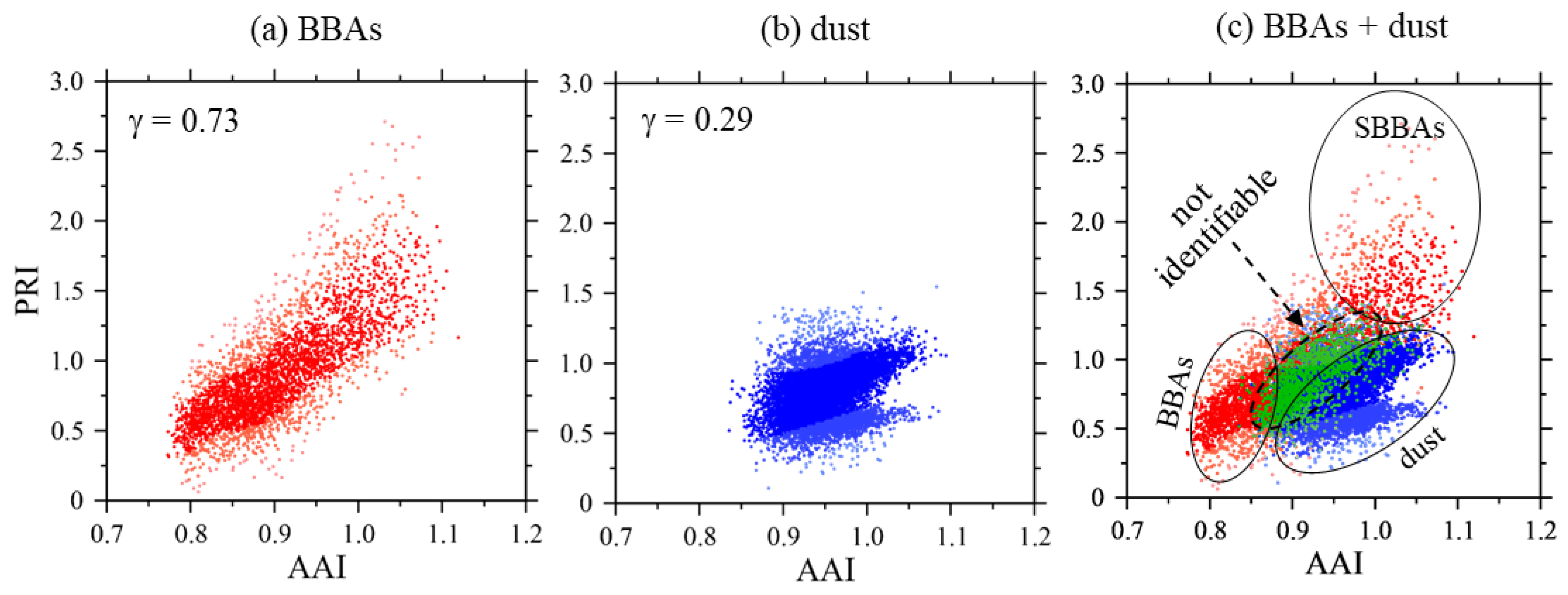
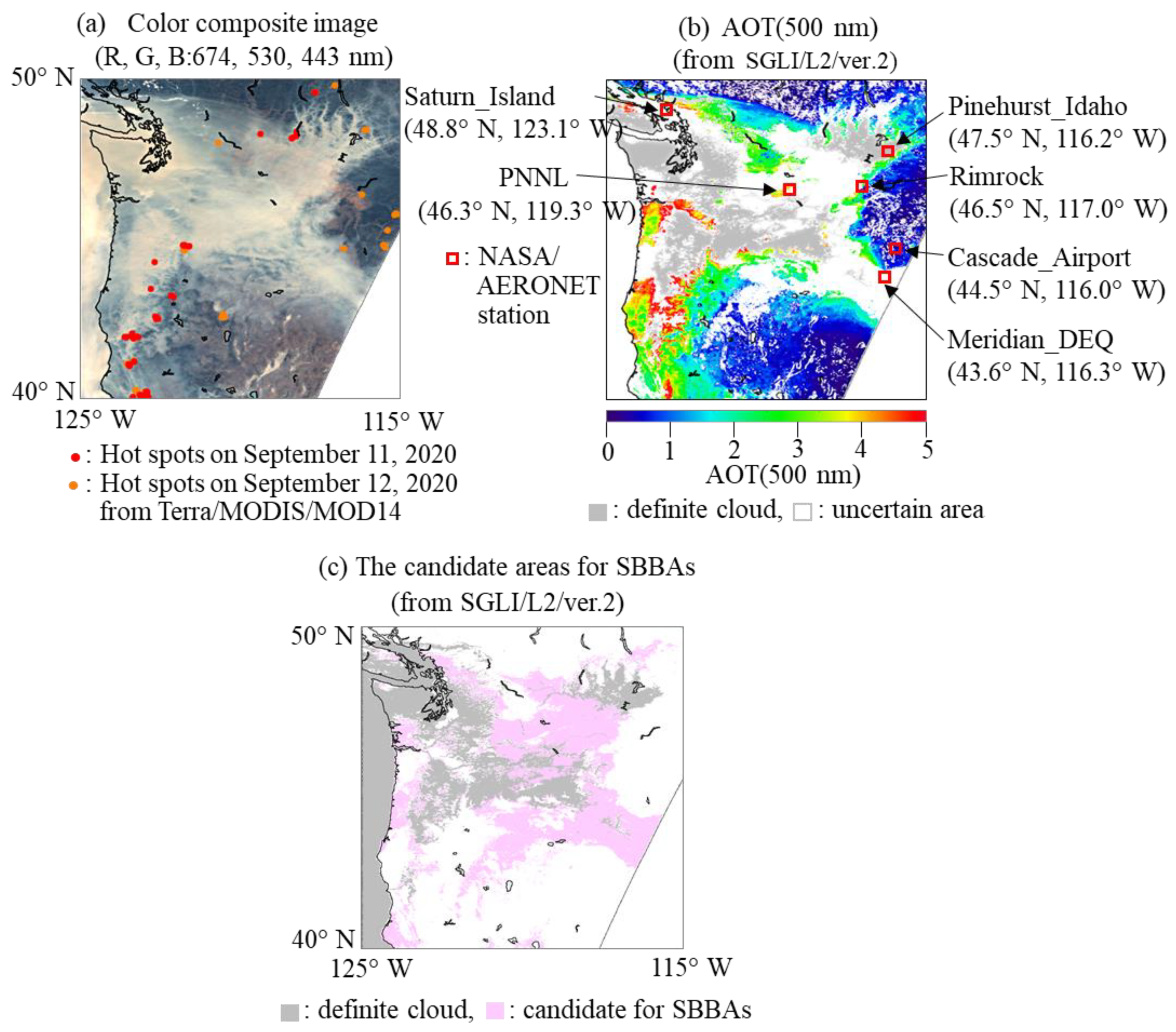
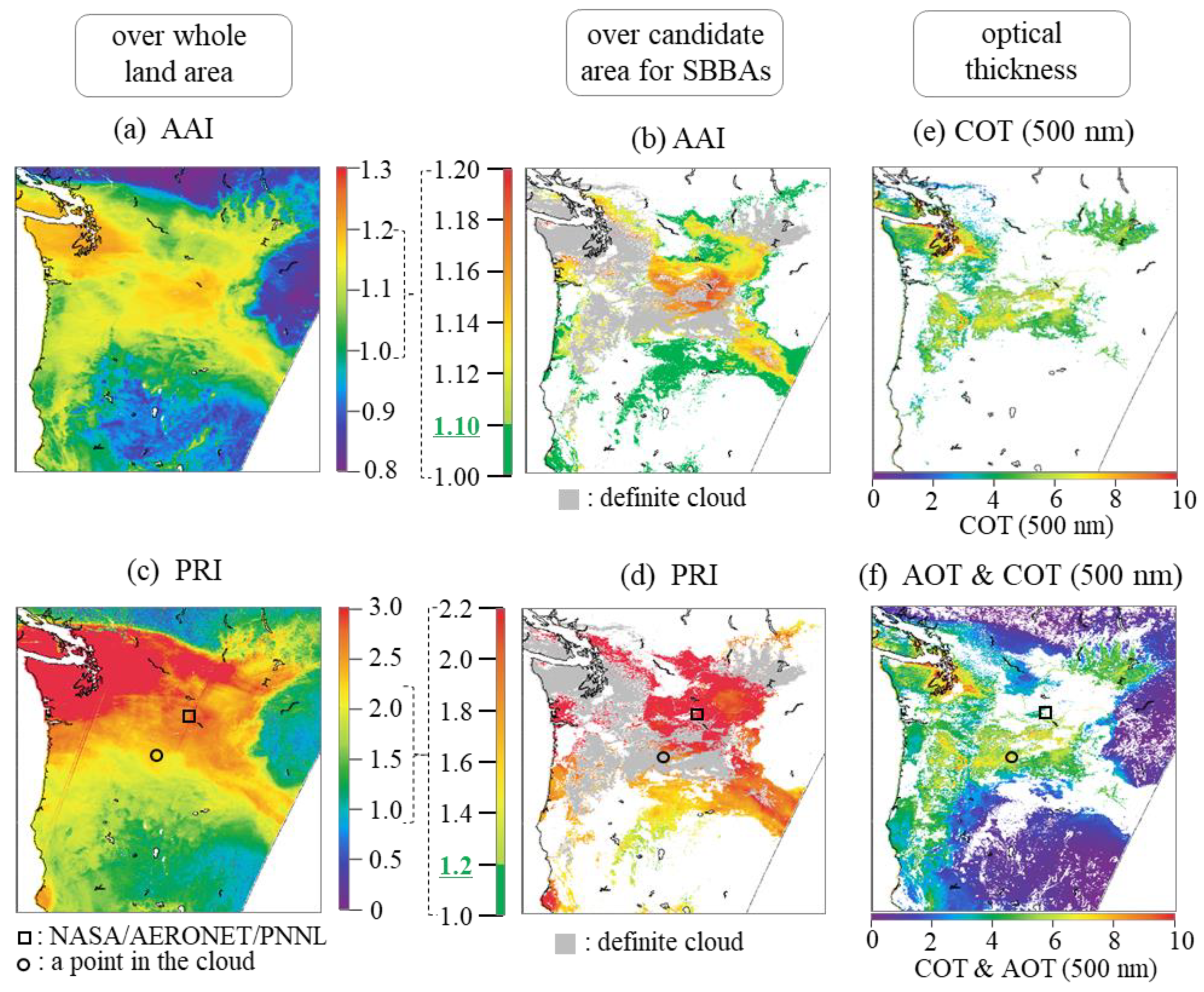
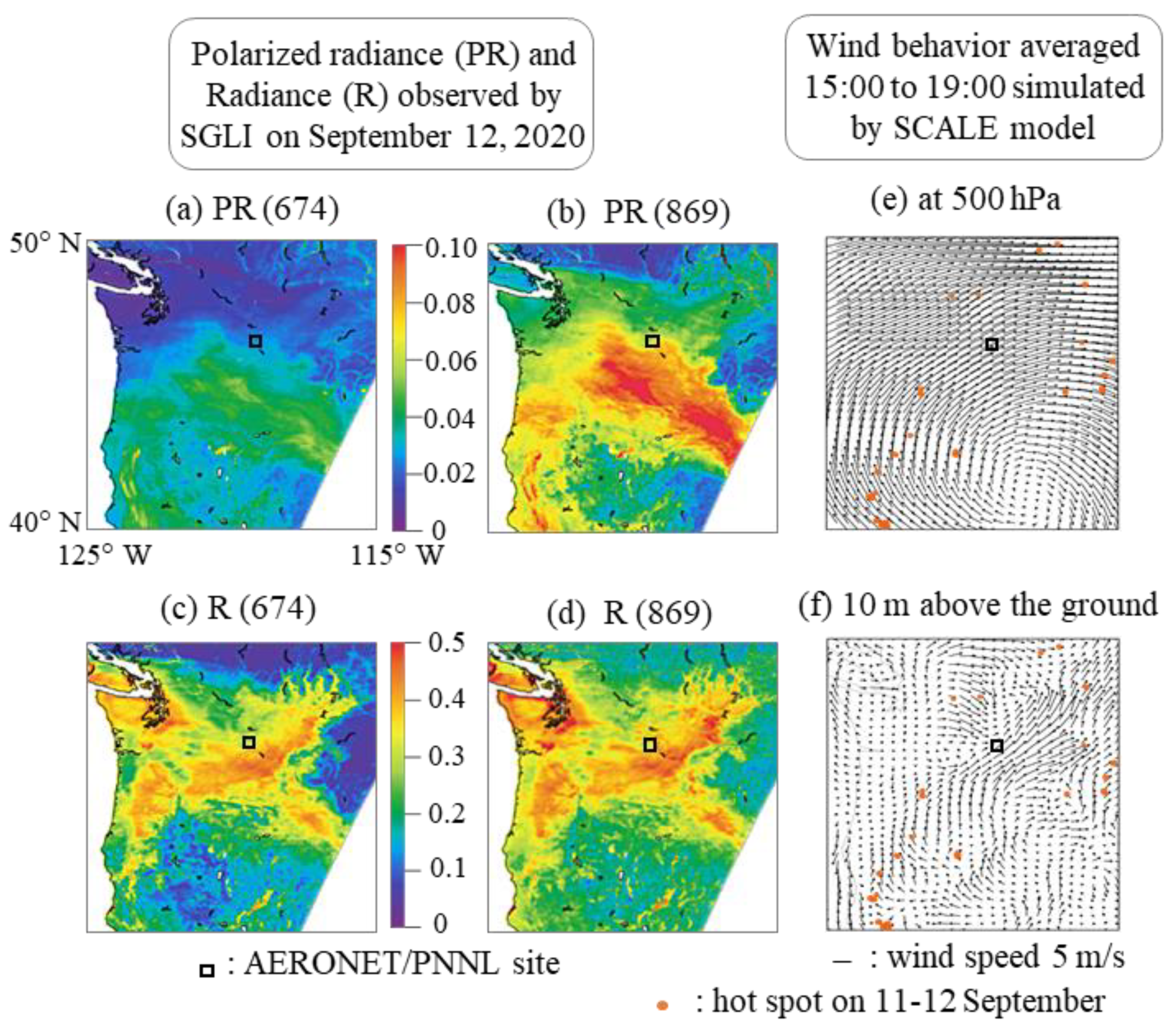

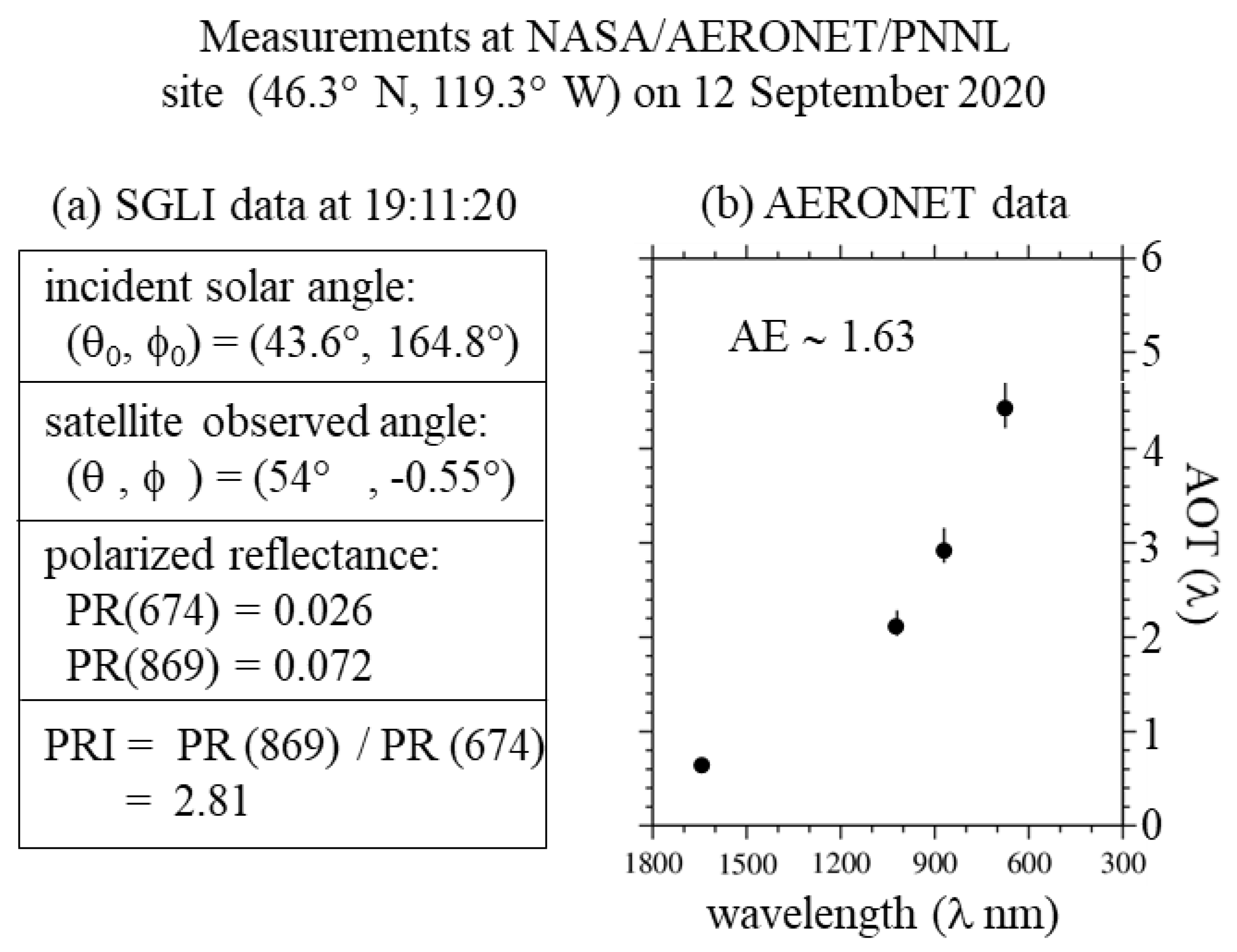
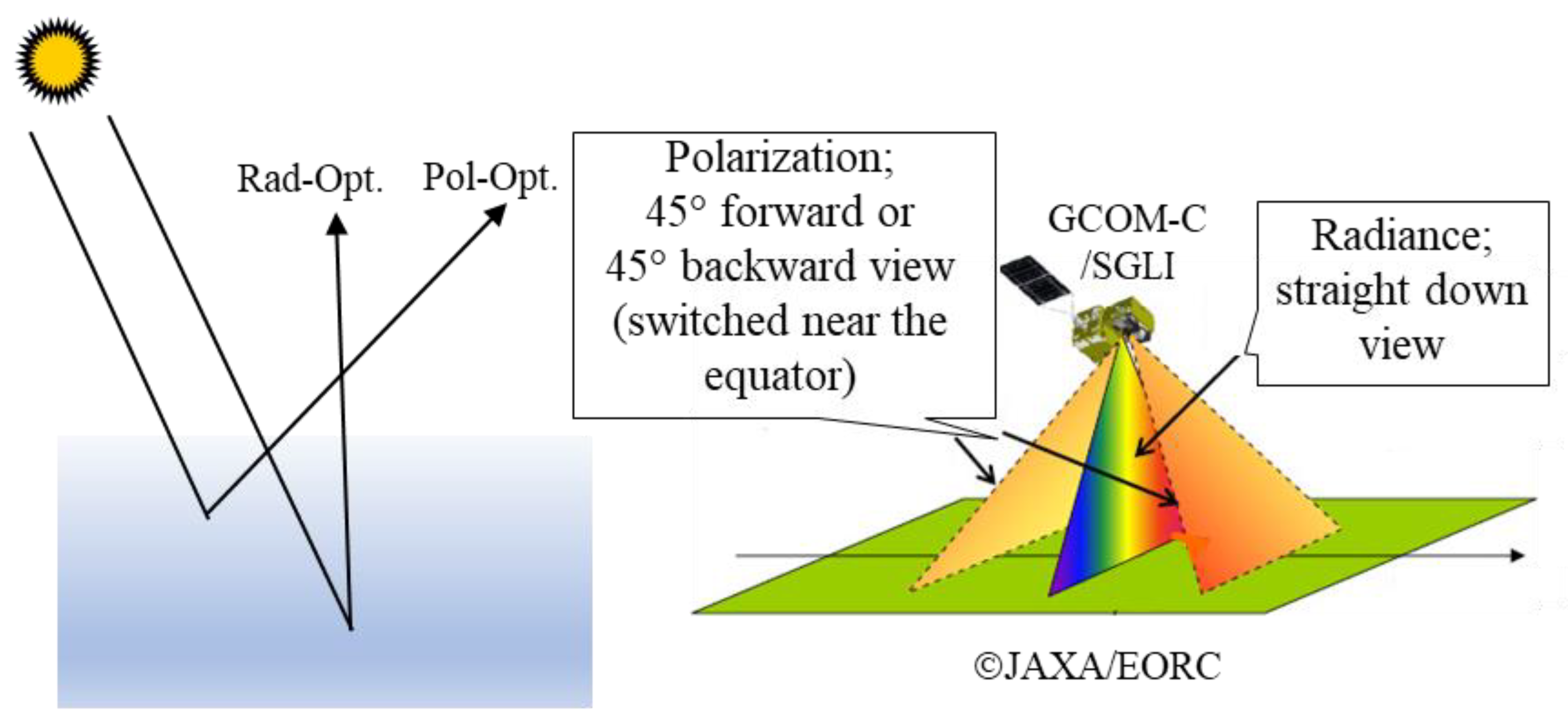
Publisher’s Note: MDPI stays neutral with regard to jurisdictional claims in published maps and institutional affiliations. |
© 2022 by the authors. Licensee MDPI, Basel, Switzerland. This article is an open access article distributed under the terms and conditions of the Creative Commons Attribution (CC BY) license (https://creativecommons.org/licenses/by/4.0/).
Share and Cite
Nakata, M.; Mukai, S.; Fujito, T. Direct Detection of Severe Biomass Burning Aerosols from Satellite Data. Atmosphere 2022, 13, 1913. https://doi.org/10.3390/atmos13111913
Nakata M, Mukai S, Fujito T. Direct Detection of Severe Biomass Burning Aerosols from Satellite Data. Atmosphere. 2022; 13(11):1913. https://doi.org/10.3390/atmos13111913
Chicago/Turabian StyleNakata, Makiko, Sonoyo Mukai, and Toshiyuki Fujito. 2022. "Direct Detection of Severe Biomass Burning Aerosols from Satellite Data" Atmosphere 13, no. 11: 1913. https://doi.org/10.3390/atmos13111913
APA StyleNakata, M., Mukai, S., & Fujito, T. (2022). Direct Detection of Severe Biomass Burning Aerosols from Satellite Data. Atmosphere, 13(11), 1913. https://doi.org/10.3390/atmos13111913






